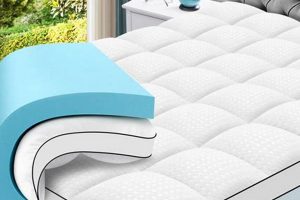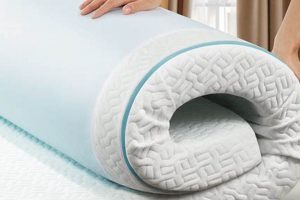A sleep surface addition, approximately four inches in thickness, designed to be placed atop an existing mattress to enhance comfort and support. As an example, a memory foam product of this dimension can modify the feel of a firm mattress, providing a softer, more conforming sleep experience.
These thicker additions offer significant improvements in pressure relief and spinal alignment. Individuals seeking to alleviate back pain or improve sleep quality may find these products beneficial. Historically, supplementary bedding layers have been used to adjust sleep surfaces, with modern materials allowing for consistent and predictable performance. The increasing availability of diverse materials and constructions has further contributed to their popularity.
The following sections will delve into the materials commonly used in their construction, the specific benefits they offer, and factors to consider when selecting one for optimal sleep quality.
Guidance on Utilizing a Sleep Surface Enhancer
The following tips offer guidance to optimize the selection and utilization of an enhanced sleep surface, addressing key considerations for improved rest.
Tip 1: Material Selection: Prioritize material based on individual needs. Memory foam offers contouring and pressure relief, while latex provides responsiveness and durability. Consider hypoallergenic options for sensitive individuals.
Tip 2: Density Assessment: Evaluate foam density, particularly for memory foam. Higher density typically indicates greater support and longevity, though it may also result in a firmer feel.
Tip 3: Proper Mattress Compatibility: Ensure compatibility with the existing mattress. A product placed on a severely sagging mattress will not provide optimal support. Address underlying mattress issues prior to implementing this enhancement.
Tip 4: Breathability Considerations: If overheating is a concern, select products with enhanced breathability features, such as open-cell foam or cooling gel infusions. These features promote airflow and regulate temperature.
Tip 5: Secure Attachment: Utilize secure attachment methods, such as elastic straps or fitted sheets, to prevent slippage. Secure placement maintains consistent support and prevents disruption during sleep.
Tip 6: Regular Maintenance: Implement regular maintenance procedures, including airing out the product periodically and spot cleaning stains promptly. Proper maintenance extends the lifespan and maintains hygiene.
Tip 7: Consider Trial Periods: Whenever possible, opt for retailers offering trial periods. This allows for evaluation of the product’s suitability for individual needs before making a final commitment.
Adhering to these recommendations facilitates the selection and utilization of a sleep surface enhancer, ultimately contributing to improved sleep quality and overall well-being.
The concluding sections will provide a summary of the key factors discussed, emphasizing the importance of personalized selection for achieving optimal sleep comfort.
1. Pressure Point Relief
Pressure point relief is a critical benefit attributed to supplemental sleep surfaces. Its significance stems from the reduction of concentrated stress on specific areas of the body during sleep, directly impacting comfort and overall sleep quality. The integration of this attribute within the design of a sleep surface of a specific depth directly addresses these concerns.
- Material Conformity and Distribution
The ability of a material to conform to the body’s contours is paramount. Memory foam, for instance, distributes weight evenly, minimizing concentrated pressure on areas such as the hips, shoulders, and back. This characteristic effectively reduces discomfort and potential pain, leading to a more restful sleep experience. A product constructed with high-density conforming foam will provide enhanced weight distribution, resulting in a higher level of support and comfort.
- Thickness and Load Capacity
The product’s dimensions influence its capacity to alleviate pressure. A greater thickness allows for a more substantial buffer between the sleeper’s body and the underlying mattress, maximizing the cushioning effect. This is particularly relevant for individuals with higher body mass, who may experience increased pressure on certain points. Adequate thickness ensures that pressure is effectively absorbed and distributed, preventing discomfort.
- Impact on Circulation
Prolonged pressure on specific body areas can impede circulation, leading to numbness, tingling, and discomfort. By reducing pressure points, circulation is improved, contributing to a more comfortable and undisturbed sleep cycle. Materials that promote airflow can further enhance this effect by regulating temperature and minimizing moisture buildup, further promoting improved circulation.
- Long-Term Musculoskeletal Health
Consistent pressure point relief can contribute to long-term musculoskeletal health. By minimizing stress on joints and muscles, the likelihood of developing chronic pain or discomfort is reduced. This preventative measure is particularly important for individuals with existing musculoskeletal conditions or those prone to developing such issues. The sustained support and pressure distribution offered can significantly improve long-term comfort and well-being.
The preceding facets highlight the integral role of pressure point relief in achieving optimal sleep quality. A product specifically engineered to provide this relief contributes significantly to improved comfort, circulation, and long-term musculoskeletal health. Selection should prioritize materials and construction that effectively address individual pressure point concerns, ultimately enhancing the sleep experience.
2. Spinal Alignment Support
The addition of a sleep surface modification, specifically one measuring four inches in depth, can directly influence spinal alignment during sleep. A primary function of such a product is to adjust the support characteristics of the existing mattress, thereby optimizing the position of the spine. In instances where a mattress is either too firm or too soft, the supplementary layer serves as a corrective measure, promoting a neutral spinal posture. For example, an individual experiencing back pain due to an overly firm mattress might find relief through the conforming properties of a memory foam addition of this thickness. The material allows the body to sink slightly, reducing pressure on the spine and encouraging natural alignment.
The effectiveness of spinal alignment support is dependent on material composition and density. A product constructed from high-density foam will provide greater resistance to compression, offering more consistent support across the body. Conversely, a low-density foam may compress unevenly, potentially exacerbating spinal misalignment. Furthermore, the location of support within the supplementary layer is crucial. Zoned support systems, where specific areas of the addition are designed to provide varying levels of support, can further enhance spinal alignment. For instance, a zoned product may offer firmer support in the lumbar region and softer support in the shoulder region, accommodating the body’s natural curves.
Achieving optimal spinal alignment requires careful consideration of individual sleep preferences and body type. While a supplementary layer can improve alignment, it is not a universal solution. Individuals with pre-existing spinal conditions should consult with a healthcare professional to determine the most appropriate sleep surface configuration. Furthermore, proper pillow selection is essential for maintaining cervical spine alignment. The combination of a supportive sleep surface and an appropriate pillow can significantly contribute to improved sleep quality and reduced back pain. Therefore, when addressing spinal alignment issues, an informed and personalized approach is necessary for achieving desired outcomes.
3. Motion Isolation Capability
Motion isolation capability, a key characteristic of certain sleep surface additions, refers to the ability of a mattress or overlay to minimize the transfer of movement from one area of the sleep surface to another. This is particularly relevant when considering a supplementary layer of specific dimensions, as its material composition and thickness directly influence the degree to which motion is contained. The reduction of motion transfer contributes to improved sleep quality, especially for individuals sharing a bed.
- Material Damping Properties
The inherent damping properties of the material are a primary determinant of motion isolation effectiveness. Materials such as memory foam and dense latex exhibit high damping coefficients, meaning they effectively absorb and dissipate energy from movement. For instance, when one partner shifts position during sleep, a supplementary layer made of high-density memory foam will absorb the motion, preventing it from propagating across the sleep surface and disturbing the other partner. In contrast, a product made of interconnected springs will tend to transmit motion more readily.
- Thickness and Surface Area Contact
The depth and surface area contact of the supplementary layer impact its ability to isolate motion. A product of a specific depth provides a substantial buffer between the sleeper and the underlying mattress, increasing the distance over which motion must travel. This increased distance reduces the intensity of motion transfer. Furthermore, a greater surface area contact between the supplementary layer and the mattress ensures that movement is distributed across a larger area, further minimizing localized disturbance.
- Density and Structural Integrity
The density and structural integrity of the materials contribute to motion isolation. Higher-density foams resist compression and deformation, preventing movement from easily transferring. A structurally sound product maintains its shape and support, even when subjected to localized pressure. This resistance to deformation minimizes the propagation of motion across the sleep surface. Lower-density foams, on the other hand, may compress readily, allowing movement to transfer more easily.
- Layer Construction and Decoupling
The construction of the product, including the layering of different materials, can enhance motion isolation. Decoupling layers, which are specifically designed to isolate movement, can be incorporated into the product’s construction. These layers act as barriers, preventing motion from transferring between different sections of the sleep surface. For example, a product with a decoupled layer of gel-infused memory foam can provide both pressure relief and enhanced motion isolation. The strategic layering of materials with different damping properties optimizes overall performance.
In summary, motion isolation capability is a crucial consideration when selecting a supplemental sleep surface. The material composition, thickness, density, and construction of the product all contribute to its effectiveness in minimizing motion transfer. Prioritizing these factors can significantly improve sleep quality, particularly for individuals sharing a bed, by reducing disturbances and promoting uninterrupted rest. Understanding the interplay of these elements allows for informed decision-making when selecting a supplementary layer that effectively isolates motion and enhances sleep.
4. Temperature Regulation Properties
Temperature regulation properties represent a significant consideration in the selection of sleep surface modifications, particularly those measuring four inches in thickness. The composition and construction of these additions directly influence heat retention and dissipation, affecting sleeper comfort and potentially disrupting sleep cycles if not adequately addressed.
- Material Breathability and Airflow
The inherent breathability of the material significantly impacts temperature regulation. Open-cell foam structures, for example, allow for greater airflow compared to closed-cell alternatives. This enhanced airflow facilitates the dissipation of heat away from the sleeper’s body, preventing overheating. Conversely, a less breathable material will trap heat, leading to discomfort. Natural fibers, such as cotton or wool, often exhibit superior breathability compared to synthetic materials. The choice of material should align with individual temperature preferences and environmental conditions. A product with enhanced airflow characteristics is more suitable for warmer climates or individuals prone to night sweats.
- Heat Dissipation Technologies
Various technologies are incorporated into sleep surface modifications to enhance heat dissipation. Gel infusions, for instance, are commonly used in memory foam to absorb and dissipate heat away from the body. Phase change materials (PCMs) can also be integrated, which absorb or release heat as they transition between solid and liquid states, regulating temperature fluctuations. The effectiveness of these technologies depends on the concentration and distribution of the cooling agents within the material. Products incorporating these technologies are often marketed as “cooling” or “temperature-regulating,” indicating their enhanced ability to manage heat.
- Density and Heat Retention
The density of the material correlates with its heat retention capacity. Higher-density foams tend to retain more heat compared to lower-density foams due to reduced airflow. While high density can provide enhanced support and durability, it may also contribute to overheating, particularly in warmer environments. This trade-off between support and temperature regulation necessitates careful consideration based on individual needs. A lower-density product may be preferable for individuals who tend to sleep hot, even if it compromises slightly on long-term durability.
- Cover Material and Moisture Wicking
The cover material significantly influences temperature regulation. Fabrics that wick moisture away from the body, such as bamboo or performance knit fabrics, help to keep the sleeper dry and comfortable. These materials facilitate the evaporation of sweat, preventing the buildup of moisture and reducing the sensation of overheating. Conversely, less breathable cover materials can trap moisture, leading to discomfort. The choice of cover material should complement the core material of the sleep surface addition to optimize temperature regulation. A moisture-wicking cover paired with a breathable foam core provides the most effective combination for managing heat.
These facets highlight the complex interplay between material properties, construction techniques, and temperature regulation. Selecting a four-inch sleep surface modification requires careful consideration of these factors to ensure optimal thermal comfort and prevent disruptions to sleep quality. Ultimately, the ideal product will balance support, durability, and temperature regulation to meet individual needs and preferences.
5. Enhanced Mattress Longevity
The extension of a mattress’s usable lifespan represents a tangible economic and practical benefit for consumers. The placement of a sleep surface modifier, particularly one measuring four inches in depth, serves to mitigate wear and tear on the underlying mattress, contributing to its prolonged performance.
- Pressure Redistribution and Core Protection
The primary mechanism by which a supplementary layer enhances longevity involves the redistribution of pressure across the sleep surface. By absorbing and dispersing weight, it reduces the localized stress on the mattress core, preventing premature sagging and deformation. For example, innerspring mattresses are particularly susceptible to localized wear in areas that bear the most weight, such as the hip and shoulder regions. A sleep surface modifier acts as a buffer, absorbing much of this stress and preserving the structural integrity of the underlying springs. This effect is especially pronounced with thicker supplemental layers capable of providing substantial cushioning.
- Contamination Barrier and Hygiene Maintenance
A sleep surface addition functions as a barrier against contaminants such as sweat, body oils, and dust mites, which can degrade mattress materials over time. These contaminants can penetrate the mattress cover and contribute to the breakdown of foam and fibers, leading to reduced support and hygiene issues. A supplemental layer, particularly one with a waterproof or stain-resistant cover, prevents these contaminants from reaching the mattress, maintaining its cleanliness and extending its lifespan. Regular cleaning and maintenance of the supplementary layer are crucial to preserving its effectiveness as a contamination barrier.
- Reduced Friction and Abrasion
Friction between the sleeper and the mattress surface can contribute to wear and tear, particularly on the cover material. A supplementary layer provides a smoother, more consistent sleep surface, reducing friction and abrasion. This is especially relevant for individuals who toss and turn frequently during sleep, as these movements can exacerbate wear on the mattress cover. By minimizing friction, the supplemental layer preserves the integrity of the mattress cover, preventing tears, pilling, and other forms of damage.
- Mitigation of Compression Set and Degradation
Over time, mattresses are prone to compression set, a phenomenon where the materials permanently lose their original loft and support. A supplementary layer can mitigate compression set by absorbing much of the compressive force, reducing the stress on the mattress core. This effect is particularly noticeable with memory foam mattresses, which are susceptible to compression set in areas of concentrated pressure. By providing additional cushioning and support, the supplemental layer slows down the degradation process, preserving the mattress’s ability to provide adequate support over a longer period.
The integration of a supplementary layer, notably one of significant thickness, such as a four-inch model, provides a multifaceted approach to enhancing mattress longevity. By redistributing pressure, acting as a contamination barrier, reducing friction, and mitigating compression set, it significantly extends the usable lifespan of the underlying mattress, offering both economic and practical benefits to the consumer. Regular maintenance and appropriate selection of the supplemental layer based on individual needs further optimize its effectiveness in preserving mattress integrity.
Frequently Asked Questions
This section addresses common inquiries regarding supplementary sleep surfaces, specifically focusing on the four-inch dimension.
Question 1: What is the primary benefit of a four inch mattress topper compared to thinner alternatives?
A four-inch depth generally provides enhanced pressure relief and support due to the increased material available for contouring and weight distribution. Thinner options may offer only minimal comfort adjustments.
Question 2: Is a four inch mattress topper suitable for all mattress types?
It is generally suitable; however, the combination with an already excessively soft mattress may result in inadequate support. Assessment of the existing mattress’s firmness is crucial.
Question 3: How does the material composition of a four inch mattress topper affect its performance?
Material significantly dictates firmness, breathability, and durability. Memory foam offers contouring, latex provides responsiveness, and down alternatives offer a plush feel. Each material possesses distinct advantages and disadvantages.
Question 4: Can a four inch mattress topper alleviate back pain?
It may alleviate back pain by improving spinal alignment and reducing pressure points. However, it is not a substitute for medical treatment. Persistent back pain warrants professional medical consultation.
Question 5: How should a four inch mattress topper be cleaned and maintained?
Cleaning protocols vary by material. Spot cleaning is generally recommended. Avoid immersing in water. Regular airing out can help maintain freshness and prevent moisture buildup.
Question 6: What is the typical lifespan of a four inch mattress topper?
Lifespan depends on material quality and usage. High-density materials generally last longer. Expect a lifespan ranging from three to seven years with proper care.
In summary, the selection and maintenance of supplementary sleep surfaces significantly impact their performance and longevity. Careful consideration of material, mattress compatibility, and cleaning protocols is essential.
The subsequent section will provide concluding remarks, summarizing key considerations for optimizing sleep quality.
Conclusion
The preceding exploration of the four inch mattress topper has elucidated its role as a significant element in sleep surface modification. The discussion has encompassed material properties, benefits relating to spinal alignment and pressure relief, and considerations for longevity and maintenance. The importance of selecting a product that aligns with individual needs and pre-existing mattress characteristics has been emphasized. This thickness generally provides a substantial enhancement to comfort and support, addressing a wide range of sleep-related concerns.
The informed application of this knowledge is crucial for consumers seeking to optimize their sleep environment. A deliberate approach to selection, incorporating factors such as material composition and intended use, will maximize the potential benefits. The continued evolution of materials and technologies within the sleep industry suggests future advancements that may further enhance the effectiveness and durability of these products, solidifying their role in promoting restorative sleep.


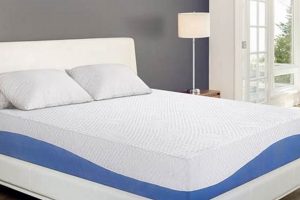
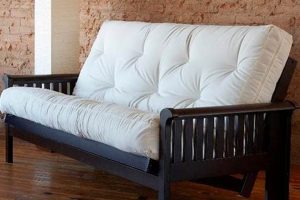
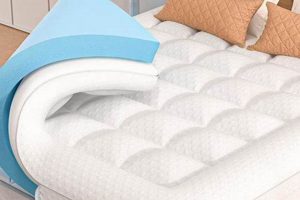
![Elevated Comfort: 24 Inch High Air Mattress - [Brand] Organic & Natural Mattress Buyer’s Guide: Non-Toxic Sleep Solutions Elevated Comfort: 24 Inch High Air Mattress - [Brand] | Organic & Natural Mattress Buyer’s Guide: Non-Toxic Sleep Solutions](https://mattressworldpa.com/wp-content/uploads/2025/07/th-3671-300x200.jpg)
